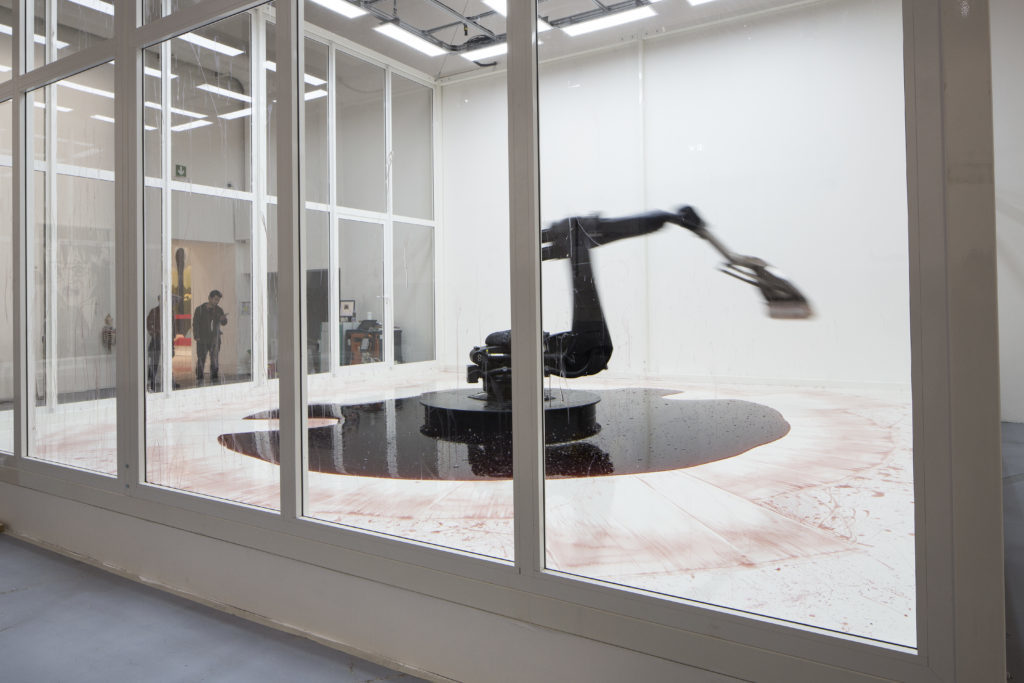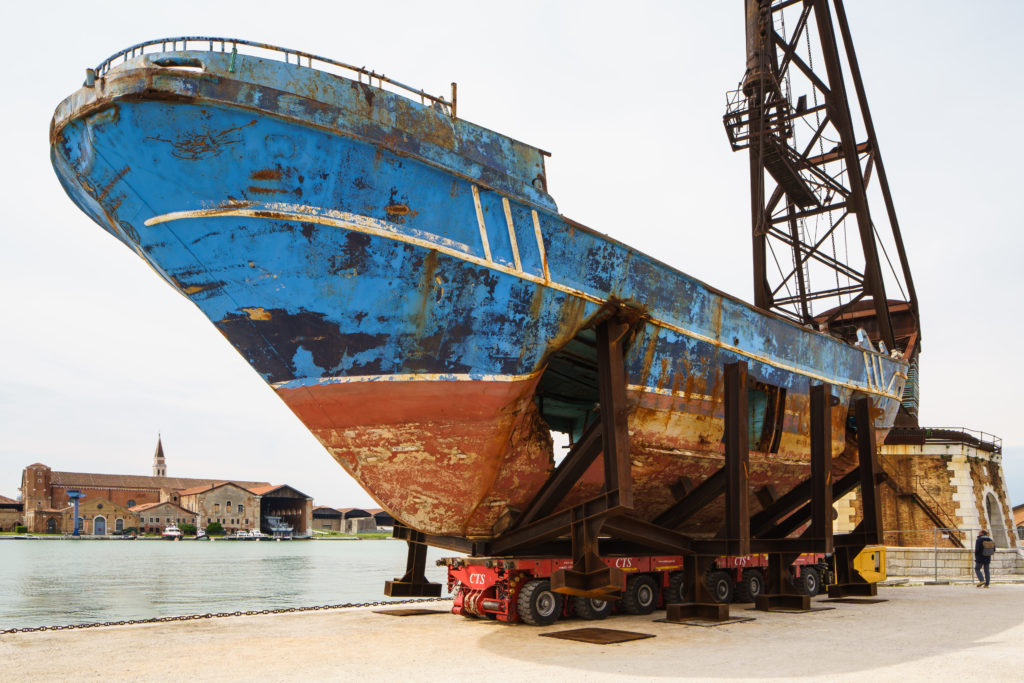The Privilege of Proximity: La Biennale di Venezia // A Sinking Ship
by Rashayla Marie Brown

Writing a first-time review as an emerging artist about the largest and oldest art biennial has led me down a corridor of binaries, squarely placing myself somewhere in the middle of maker and critic. These binaries function to preserve the terms which give touristic art criticism its meaning–quality, curation, economy, and proximity. Like all binaries, they are unsatisfying conclusions that leave us stretched thin, which feels very much like the Biennale, the most stressful vacation one might take. In My Art Guides: Venice 2019, this edition’s curator Ralph Rugoff admits that “being in Venice completely distresses [him] unless [he] runs into a herd of tourists.” After being ignored by waitstaff in one restaurant and cursed at for attempting to charge my phone in another, I come to the conclusion that maybe he meant white tourists.
This leads me to a first set of binaries—the privileged versus the underprivileged. The concept of the nation-state and a global Olympics appeared around the same time that the first Venice Biennale took place in 1895, ten years removed from Leopold II eviscerating the Congo as his personal playground. The history of the world’s fair, an event in which colonial endeavors and scientific advancements of European nations and the United States could be put on display for entertainment, weaves itself so deeply into this history that we often hear calls to burn down the concept altogether. Critiques of how vulgar money has become in the art world usually only manage to hold together if we imagine art was ever polite or untainted by it in this context of display.
The issue of financing the Biennale has come up in reviews published within The New York Times and the UAE’s The National, pointing to the gallerists present in Venice to “find homes” for artworks by artists on display in the former, and the hidden cost of presenting in the latter. A lack of funding may even make this year’s award-winning Lithuanian pavilion incapable of restaging the performance more than once a week for the remainder of the exhibition. After refusing to wait in line for three hours to see Lithuania, France, and the United Kingdom, I opted to take a detour to pavilions that nobody would care about, the poorly-financed triad of pavilions tucked away: a Caribbean hideaway for the Dominican Republic, Grenada, and Guatemala. What I found was a group of Italian artists and curators representing these nations, a video screen turned off, and a sad hanging of paintings with tropical themes. Finally, as I arrived at the Grenada Pavilion, I came to a tender and emotionally wrenching filmic installation by Grenadian artist Billy Gerard Frank, which paid tribute broadly to queerness, Derek Walcott, and a relentlessly cold father. Upon searching the pavilion’s contribution, I found that Frank had to launch a GoFundMe campaign to participate.
Artists and curators alike have lamented the cost of the privilege for being in this artworld, and with this in mind, it would even seem pointless to critique quality without it. What is a good work, all things being equal financially? A standout piece—maybe just for scale and cool factor of engineering—could be Sun Yuan and Peng Yu’s massive robot, compulsively painting blood-like material in the main exhibition May You Live in Interesting Times at the Giardini, entitled I Can’t Help Myself (2016).
Even better, might be Yuan and Yu’s Dear (2015), a hose whipping violently from the seat of a replica of the Lincoln monument, scarring the plexiglass cage around it on view in the same exhibition at the Arsenale. However, in this discourse about money, the pieces could also generate conversations about financing, subjectivity, and national identity. The ridiculousness of the individual artists’ subjectivity becomes most apparent in a context of international travel that buttresses national identity through their work. This binary—one subjectivity versus a nation’s culture that programs it—compels us to travel, to be a citizen of the absurd social fiction we call the artworld.
Within that fiction, a compelling question remains—were these artistic choices the right ones? Briskly reviewing the Arsenale and Giardini’s main exhibition housed in two parts, I noted most artists used the two chances to represent their practices (a first that nods to Rugoff’s oft-noted “playful” sensibility as a curator) by opting to show a range of multi-hyphenate diversities and mediums. Examples include Arthur Jafa, choosing to show a film and a set of objects, Tavares Strachan’s neon installation followed by a set of prints, and the collaboration between Korakrit Arunanondchai, Alex Gvojic, and boychild, that begat a film in one sector and a nature-inspired installation in another. Then, their choices could not possibly be wrong.

In the aforementioned My Art Guides interview, Rugoff states his curatorial position was to find art that had fluidity, openness, and multiple interpretations, but also work that makes the viewer aware of things that most do not pay attention to. The fact that Jafa won the Golden Lion for a moving film about white people being violent and terrible, as much as they are subjects of his love, means that perhaps white people still do not know how they look to anyone who is not. My takeaway from the pavilions: if you are not talking about the immigrant, the Other, bodies, technology, and the Internet as tools or weapons, and you are not being mysterious enough to be misunderstood, then what are you talking about?
Many national presentations desperately evacuated themselves of this contention, such as the women-centric presentations by Saudi Arabia and the United Arab Emirates, which are formally and physically impressive while maintaining anachronistic political neutrality, complete with friendly, smiling female attendants. Others bang you over the head with their history of violence, such as the well-designed, well-researched, and extremely didactic Chilean pavilion—replete with a gory Subalterns portrait gallery. In these such Examples, there is nothing left to be misunderstood. It is within this landscape that the eagerly anticipated Ghana Pavilion is perfect, without blemish. Intergenerational, moody, and formally consistent, photography and painting are shown alongside films with up-to-the-minute social critique and alarmingly emotive cinematography. Yet, what I noted at the superexclusive Ghana party was the all-star component of this installation, and that the stylishness of African classism often produces work that does not do anything to systemically change institutions that uphold unequal representation and discrimination. This contrast between style and substance is easily confusing if one expects it to change how Black bodies will be either accepted or misrepresented in Venice in the future.
This polemic drew me to the most “emerging” artist in the group curated into the Ghana Pavilion, also one of the few to actually be Ghanaian, Selasi Awusi Sosu. Her video installation, which contemplates glass as both a metaphor and an actual material produced in Ghana, highlights issues of national importance while simultaneously acknowledging the people who helped her to produce the work. She admits the fears of national representation (“I understood that I could not disappoint the nation. Neither could I disappoint my teachers, nor students, nor family!”) while also retaining a generous view of the touristic aspect of the Biennale (“The ‘cult object’ is not totally shattered! The aura of authenticity is still relevant and sought after.”) Sosu plans to show the work after Venice to underprivileged audiences in Ghana, including young audiences both in and out of school. For some artists, the work is never really done. The Venice moment extends far beyond what is happening in the Pavilion itself—perhaps one reason why more and more artists will likely go into debt seeking to participate.
Talking to Strachan as a return participant (he previously represented the Bahamas in 2013) about his work, we landed on the subject of privilege at my prodding. Beyond the formal characteristics of his work, he spoke to the moments when his work went beyond the magical into the practical: “When I think of the context [of Venice], and the elements of potential tokenism, it is good to remember that the needle is not moving for a lot of people.” There was a moment when, beyond making a beautiful object, Strachan’s work actually led to the inclusion of first Black astronaut Robert Henry Lawrence Jr. in a major research archive. This leads me to another binary art criticism relies on—does the work do something political or does it only represent something political? Recent critiques of the Whitney Biennial claim that since the work does not destabilize the power that actually exists at the museum on a board level, it failed. When we evaluate work based upon that criteria, then we must start to question whether our first evaluative criteria—quality, curation, economy, and proximity—mean anything at all.
One of the most polarizing pieces in regard to this moral dilemma regarding political art could easily be Cristoph Büchel’s display of the wrecked boat where almost 1,000 African migrants died on their way to Italy. Panned by The Art Newspaper and The Guardian, Büchel’s Barca Nostra (2019) prompted an experience where many viewers took selfies, having no idea what they were looking at (because no label was provided). However, the piece prompted DC-based artist Tsedaye Makonnen to stage an impromptu performance in front of it, to memorialize the lives lost. Speaking over the phone, Makonnen stated that her performance produced an intervention by plainclothes police that led to harassment of Black viewers to produce “papers” or their passports. In this context, Büchel’s piece, with the help of Makonnen, did the work of producing a political effect in real-time. Routine state violence against Black bodies and the particular brand of Italian racism was staged in front of a piece dedicated to the callousness with which migrants are treated. Only a couple weeks later and some feet away, a luxury cruise ship crashed into the dock of Giudecca Canal, injuring multiple tourists. The threat of climate change and tourism to Venice’s unique layout puts it a precarious position to even be a refuge for people who experience anti-Blackness that refuses to call itself such. The work now highlights this.
I was curious about Makonnen’s inclusion in the Biennale, as a relative outsider. The binary of inside and outside previously discussed is highlighted by her work—she represents the majority of artists who attend the events. She speaks to those who feel like they are maneuvering for visibility to a group of the socially blind through metaphors of migration and color: “I feel like I am a similar boat, trying to figure out what it is that I want. Am I chasing this validation from white people and white culture? Visibility is necessary for black and brown people. We need to be able to see ourselves in them, but I think about being blacklisted a lot.” In this sense, the strength of the artist’s work is that it requires our investment—in her career and over time—to assess it. As artists of color, we share a fear that perhaps the systems we want inclusion in, such as the Ghana Pavilion, are reproducing the same paradigms of power by proximity.
We will have to see if these interventionist gestures of visibility place us on the sinking ship.